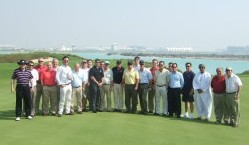 Leading golf industry figures from across the Middle East gathered in Abu Dhabi to attended the inaugural ‘Golf in the Middle East – The Next Generation’ seminar which called for greater sustainability to ensure the sport’s future growth and success.
Leading golf industry figures from across the Middle East gathered in Abu Dhabi to attended the inaugural ‘Golf in the Middle East – The Next Generation’ seminar which called for greater sustainability to ensure the sport’s future growth and success.
The event, jointly organised by Golf Course Architecture, The Toro Company and golf course architects, Thomson, Perrett & Lobb, was created to help stimulate discussion and debate on the current status of golf development in the Middle East, but went beyond the region’s current golf market to consider prospects for the future.
Delegates came from a wide spectrum of the development and tourist sectors of the golf industry, including course and real estate developers, golf operations executives, golf course architects, maintenance specialists, hotel operators and masterplanners.
During the seminar, staged at Abu Dhabi Golf Club and moderated by GCA’s editor Adam Lawrence, Rob Shuttle of Abu Dhabi developer TDIC delivered the keynote speech, highlighting the need for the Middle East region to be more in-tune with the local way of life, both culturally and environmentally.
He said: “Golf course development cannot continue on the premise that bigger, greener and longer is better. Golf must be economically feasible, attractive to tourists and yet affordable for the local population and newcomers to the game.
“The Middle East must resist the temptation to create only grand golf courses at huge expense and available only to an affluent few. Affordable daily play golf should be included in the mix of grand course offerings to ensure that all have a chance to play and to foster interest throughout the younger members of the population.”
During the golf course design panel session, chaired by TPL’s Tim Lobb, the Principal of land planning firm AECOM, Kevin Underwood, echoed the thoughts of Shuttle. He added: “Sustainability in the Middle East is about energy and water. There are projects looking at solar and wind power, and the latter best of all. Social sustainability is vital too as we are losing peoples’ cultural heritages.”
Golf architect Kyle Phillips, designer of the newly-opened Yas Links in Abu Dhabi, said that the sustainability of the game was helped by courses that focus more on golf and less on the surrounding housing.
“For sustainability, the core golf course model is best,” he explained. “Often, there is a disconnect between land planning and golf. The notion that it’s all about linear frontage has got to be rethought. At Yas, for example, no-one staying in the hotels is going to feel they’ve been cheated because they are not right on the water.”
The event’s second panel, chaired by Andy Brown of Toro, examined golf course maintenance in the region.
Robin Evans, Troon Golf’s director of construction and agronomy, told delegates that the high cost of water, and the strong demand for treated sewage effluent (TSE), which currently exceeds the supply, meant that a move to less irrigated turf was inevitable.
The seminar heard that this move is already happening. “The original design of our Earth course had 50 hectares of turfgrass. Now that’s down to 33 hectares,” said Hamish McKendrick, senior manager of agronomy for Leisurecorp, developer of Jumeirah Golf Estates, which plays host to the European Tour’s Dubai World Championship.
Finally, Club Managers’ Association of Europe chief executive, Jerry Kilby, led a panel discussing golf operations and marketing.
Kilby called for a move away from the perception that all developments must be five star properties. St John Kelliher, general manager of The Wave Muscat, echoed this call, pointing out that the demand for golf tourism in the region is affected by high cost of Middle Eastern golf.
“One week of golf in the UAE is the same price as three weeks in Thailand,” he said. “Less than 15 per cent of rounds in the UAE are played by tourists. But we have to get more tourist golf. With 15 courses, there is never going to be enough local golfers to go round,” said Mark Chapleski, Troon Golf’s managing director for the Middle East.
As well as the seminar events, delegates visited a range of golf facilities in the region, including the Thomson, Perrett & Lobb-designed Dubai Golf City course, Saadiyat Beach Golf Club in Abu Dhabi, designed by Gary Player’s firm, and the Kyle Phillips-designed Yas Links.

